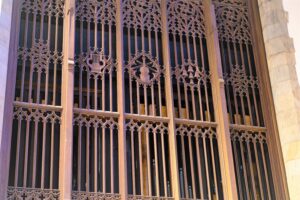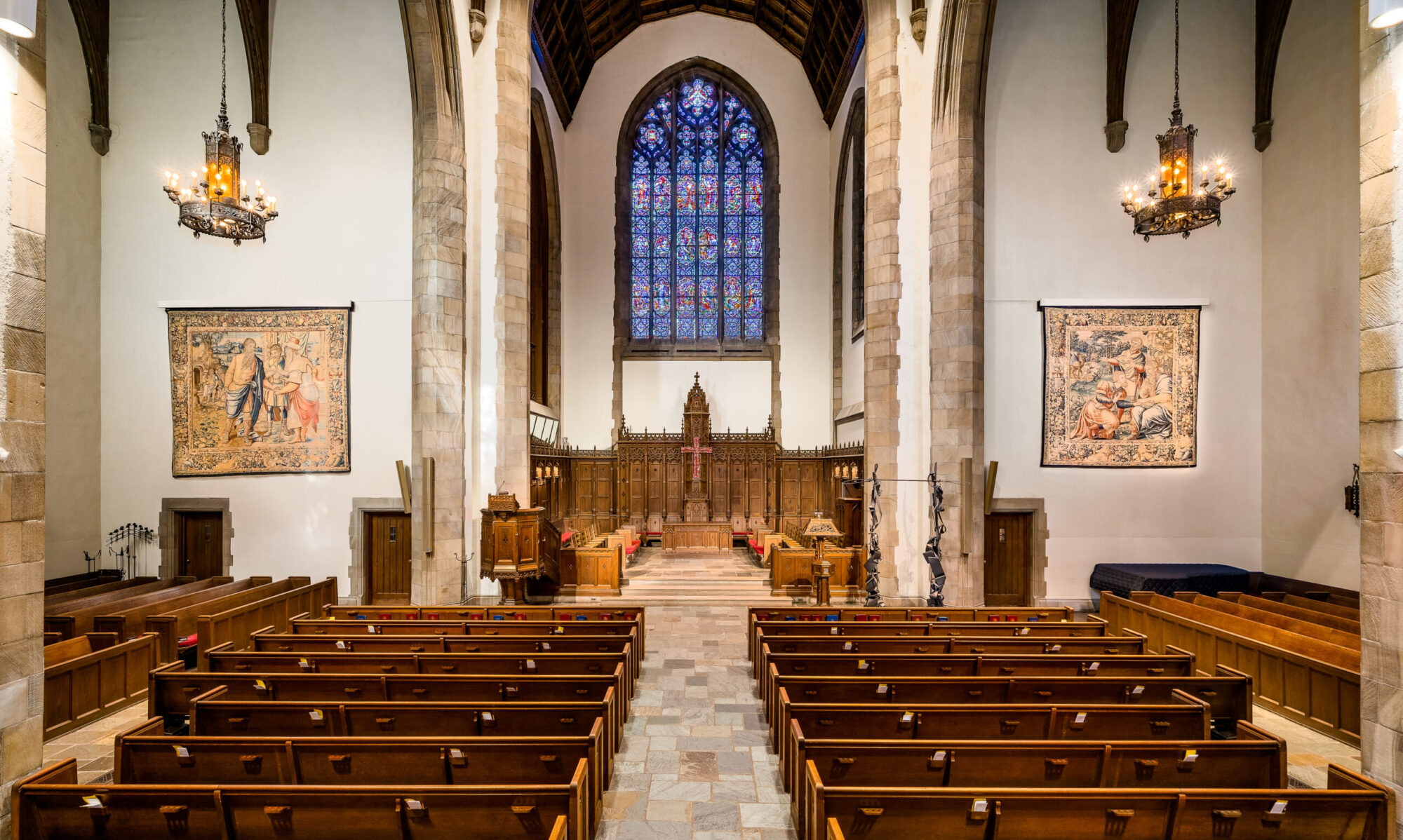Photo Credit: Jeff McCutcheon
Originally given by Alice Martin as a memorial to her late husband, Walter Henry Martin, the Martin/MacNevin organ is comprised of 74 stops and 66 ranks containing 4,419 pipes. Each of the four manuals contains 61 notes and the pedal compass is 32 notes. The Choir, Swell and Solo divisions sit atop 73 note windchest. It employs electropneumatic key and stop action.

In 1871, Albert C. Gemünder (1819-1885) received a contract to remove and move an existing organ already in the First Congregational Church, likely a ca. 1820 Thomas Appleton instrument acquired second-hand in 1863. The organ was removed in 1872 and Gemünder proposed “to make such changes as will make it one of the best as it is one of the largest in the city”. The rebuilt organ was placed in the rear of the pulpit platform, and “wings were built to the instrument, so as to give it a very pleasing appearance.
Along with a major remodeling of the sanctuary, this organ was replaced in 1887 by opus 479 built by the A. B. Felgemaker firm.
In 1913, with the inauguration of a first permanent church building, the organ was replaced with a three-manual, 30-stop instrument, opus 451, built by Austin Organ Co. The instrument was inaugurated by John Frederick Wolle (1863-1933) on October 2, 1913.
In 1931, for the next new building, a four-manual W. W. Kimball Co., of Chicago, KPO 7066, was commissioned for the sanctuary at the cost of $14,000. The specifications were drawn up by Kimball’s Robert Pier Elliot (1871-1941) in consultation with music director Glenn Grant Grabill (1882-1961). With all its six divisions enclosed behind independent swell shades, the symphonic nature of the organ is fully realized. Located in chambers in the west side of the chancel and behind a magnificently carved wooden organ screen,

it was a gift by a church member, Alice Marion Robbins Martin (1870-1958), in memory of her husband Walter Henry (1864-1929). Facing this screen, the Great and Pedal divisions are on the right side, lower level. The Solo is on the left side, lower level. Directly above the Solo division is the Swell division. The Choir sits on top of the Great. The Echo division is on the west wall of the rear gallery, behind an equally elaborate wood screen and slightly behind the Beckerath organ case. The Chimes were retained from the Austin organ that was installed in the congregation’s previous building. It was dedicated on December 13, 1931, by Glenn Grant Grabill.
By the late 1960s, the organ was experiencing maintenance issues paired with changing tastes in organ building. Because of this, and because of the new Beckerath organ that was installed in 1972, the organ was very rarely used from 1972 until 2004. Thanks to a generous bequest from Jean Hamilton MacNevin, in memory of her husband William Marshall, the organ was completely restored and renovated from 2002 to 2004 by the Peebles-Herzog Organ Co., of Columbus, with the help of thousands of hours given by church volunteers. The pipework and mechanism were restored while the internal console components and switching were replaced with modern solid state. An effort was made to retain the original Kimball console hardware and stop control devices. This magnificent four-manual symphonic organ was rededicated on September 26, 2004.
In the 1920s, a decision was made to relocate First Church to a new home at 444 East Broad Street. To match the planned scale and scope of the new John Russell Pope edifice, an equally grand organ was needed. The firm of W.W. Kimball (Chicago) was chosen to design and build an instrument for First Church’s new building. The organ was installed and dedicated in late 1931.
With all six divisions completely enclosed behind independent swell shades, the symphonic nature of the organ is fully realized. The main organ resides in the west Chancel in chambers behind a magnificently carved wooden organ screen (also a memorial gift of Alice Martin). Facing this screen, the Great and Pedal divisions are on the right side, lower level. The Solo is on the left side, lower level. Directly above the Solo division is the Swell division. The Choir sits on top of the Great. The Echo division is on the West wall of the Gallery, slightly behind the Beckerath organ case.

By the late 1960s, the organ was experiencing maintenance issues paired with changing tastes in organ building. Because of this, and because of the new Beckerath organ that was installed in 1972, she was used very rarely from 1972 until 2004. Thanks to a generous bequest from Jean MacNevin, one of the Kimball’s most ardent supporters, the organ was completely restored and renovated from 2002-2004 by the Peebles-Herzog Organ Company with the help of thousands of hours given by First Church volunteers.
This renovation returned the Kimball organ to her former glory. Today, the Martin/MacNevin Memorial organ is heard in weekly worship accompanying congregational song, choral anthems, and providing a completely different tonal palette from the fine Beckerath instrument. She is regularly heard on the Concerts at First Church series, and remains a significant asset to First Church and the international music community.
“Renowned French organist Marie-Claire Alain recently appeared at First Congregational, where she played half of her performance on the church’s Beckerath, which has 47 stops, and the other half on its Kimball, which has 73. “An organ is like a big orchestra,” she said in an interview the day before the concert. “Each of these knobs represents one person in an orchestra.” Like snowflakes, no two organs are alike, Alain said.
Even though she well knew the music, she needed to practice on each of the instruments to learn its traits, she said. First Congregational’s Beckerath, which sits in the rear balcony, is suited to baroque music, and the Kimball to early 20th-century compositions, Alain said.
She had visited the church in 1974 when the Kimball was seldom used because of its disrepair. Her insistence that the instrument be restored eventually registered with the congregation.”
New or restored, majestic organs of Downtown churches attracting interest November 4, 2005 | Columbus Dispatch, The (OH)
